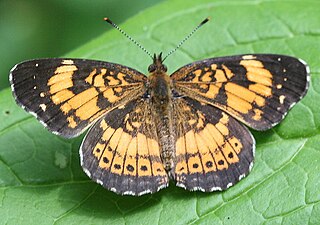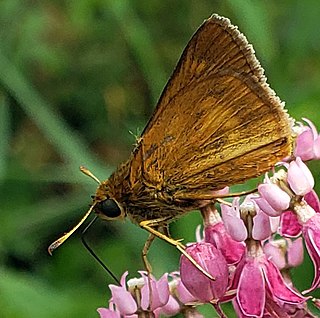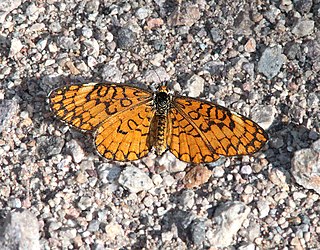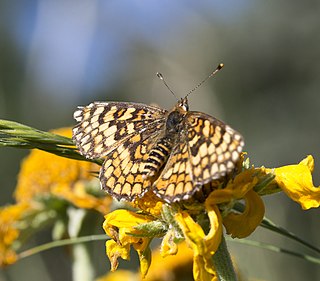
Arachne is the protagonist of a tale in Greek mythology known primarily from the version told by the Roman poet Ovid (43 BCE–17 CE), which is the earliest extant source for the story. In Book Six of his epic poem Metamorphoses, Ovid recounts how the talented mortal Arachne challenged the goddess Athena to a weaving contest. When Athena could find no flaws in the tapestry Arachne had woven for the contest, the goddess became enraged and beat the girl with her shuttle. After Arachne hanged herself out of shame, she was transformed into a spider. The myth both provides an aetiology of spiders' web-spinning abilities and was a cautionary tale about hubris.

Paul Ralph Ehrlich is an American biologist known for his predictions and warnings about the consequences of population growth, including famine and resource depletion. Ehrlich is the Bing Professor Emeritus of Population Studies of the Department of Biology of Stanford University.

Penstemon palmeri, known by the common name Palmer's penstemon, is a species of perennial flowering plant in the genus Penstemon that is notable for its showy, rounded flowers, and for being one of the few scented penstemons. The plant, in the family Plantaginaceae, is named after the botanist Edward Palmer.
Local extinction, also extirpation, is the termination of a species in a chosen geographic area of study, though it still exists elsewhere. Local extinctions are contrasted with global extinctions.

Scrophularia californica is a flowering plant in the figwort family which is known by the common names California figwort and California bee plant.

Orthocarpus, or owl's-clover, is a genus of flowering plants in the family Orobanchaceae (broomrapes). They are native to North America. A number of species formerly included in Orthocarpus have been transferred to the genus Castilleja, which includes the plants commonly known as Indian paintbrush. Plants of the genus are generally less than 30 centimetres (1 ft) in height.

The variable checkerspot or Chalcedon checkerspot is a butterfly in the family Nymphalidae. It is found in western North America, where its range stretches from Alaska in the north to Baja California in the south and extends east through the Rocky Mountains into Colorado, Montana, New Mexico and Wyoming. The butterfly is usually brown or black with extensive white and yellow checkering and some red coloration on the dorsal wing. Adult wingspan is 3.2–5.7 cm (1.3–2.2 in). Adult butterflies feed on nectar from flowers while larvae feed on a variety of plants including snowberry (Symphoricarpos), paintbrush (Castilleja), Buddleja, Diplacus aurantiacus and Scrophularia californica.

Edith's checkerspot is a species of butterfly in the family Nymphalidae. It is a resident species of western North America and among the subspecies, entomologists have long been intrigued by their many phenotypic variations in coloration, wing length, and overall body size. Most populations are monophagous and rely on plants including Plantago erecta and Orthocarpus densiflorus as their host species in developing from eggs through to larvae, pupae, and mature butterflies. Males exhibit polygyny whereas females rarely mate more than once. Males devote most of their attention to mate acquisition, and such mate locating strategies such as hilltopping behavior have developed. Climate change and habitat destruction have impacted certain subspecies. Three subspecies in particular, Euphydryas editha quino, Euphydryas editha bayensis and Euphydryas editha taylori, are currently under protection via the Endangered Species Act.

Chlosyne is a genus of butterflies from North and South America in the family Nymphalidae.

The Bay checkerspot is a butterfly endemic to the San Francisco Bay region of the U.S. state of California. It is a federally threatened species, as a subspecies of Euphydryas editha.

Euphyes conspicua, the black dash, is a butterfly of the family Hesperiidae. The species was first described by William Henry Edwards in 1863. It is found in the upper Midwest of North America, from eastern Nebraska east to southern Ontario and along the central Atlantic Coast from Massachusetts south to south-eastern Virginia. Its habitat includes shrubby or partially wooded wetland.

Dymasia is a monotypic genus of butterflies in the family Nymphalidae. Its single species is the tiny checkerspot, also known as the dyman checkerspot, which is found from the southern United States to Central America.
Euphydryas editha luestherae, or LuEsther's checkerspot, is a butterfly native to the U.S. state of California that is included in the brush-footed butterfly family Nymphalidae and the tribe Melitaeini. It is a subspecies of Edith's checkerspot, and it was described in 1980 by Dennis D. Murphy and Paul R. Ehrlich. The common and scientific names honor LuEsther Mertz.

Poladryas arachne, the arachne checkerspot, is a species of crescents, checkerspots, anglewings, etc. in the butterfly family Nymphalidae.

Euphydryas anicia, the anicia checkerspot, is a species in the family of butterflies known as Nymphalidae. It was first described by Edward Doubleday in 1847 and it is found in North America.













